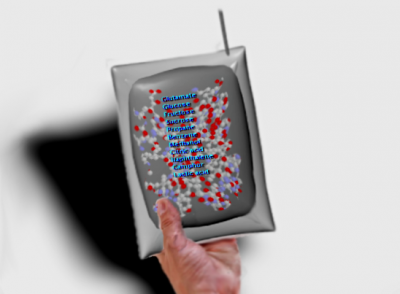BY LETTER
Chemicanalyzer
Handheld chemical analysis tool | |
 Image from Steve Bowers | |
| A softtech chemicanalyser, with needleprobe attached | |
Two streams of technological development late in the first Century AT gave rise to the chemicanalyzer. First, medical lab-on-a-chip devices became more powerful and versatile, allowing advanced medical analysis with a handheld device. Second, chemical analysis tools such as nuclear resonance scanning and x-ray dispersive spectroscopy became cheaper and more extensively used.
Techniques of miniaturization such as AT and room-temperature superconductors allowed multiple forms of analytical equipment to be carried into the field in a single unit in backpack or suitcase form, with several pencil-like probes. These were initially used in mineral prospecting, but gradually spread to other fields of endeavor.
In 97 AT these devices were combined to give a portable laboratory capable of deducing the molecular structure of almost any organic or inorganic analyte; be it gas,liquid or solid. By the Technocalypse this had been refined into handheld versions of several different models. The most popular was the size and shape of a paperback book, with a needle-like probe capable of reconfiguring itself for different samples. The face of the chemicanalyzer was a 3D screen that could display the molecular structure and a report on the properties of the substance(s). Another popular version was a wand that could interact via Direct Neural Interface with the user.
Across history numerous other designs have been developed for non-human clades of a diverse range anatomy types. Many modern versions include sensitive Olfactory Arrays to sense chemical properties remotely, using minute amounts of atmosphere-borne materials.
Related Articles
- Chemical Engineering - Text by M. Alan Kazlev, based on the original by Robert J. Hall
The macro-, micro-, meso- or nano-scale chemical conversion of raw materials into such end products as bioplastoids, synthetic petroleum products, dumb (macroscale) detergents, plastics, natural and synthetic fuels, pharmaceuticals, fullerenes, hardcopy paper, and industrial chemicals. While most products can be easily synthesized with any household nanofab, chemical engineering is still important in the mass-production of large quantities of material in large chemical plants. - Chemical Plant
- Disassembler
- Forge Integrated Technology (FIT)
- Olfactory Array
- Omnitool
- Sensors for use in Space Combat and Defence
Appears in Topics
Development Notes
Text by Tom Mazanec
Initially published on 25 February 2016.
Initially published on 25 February 2016.






